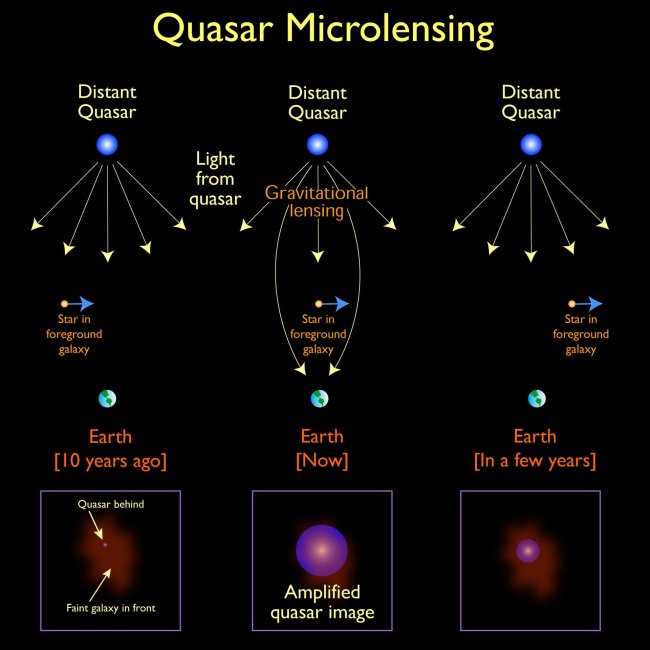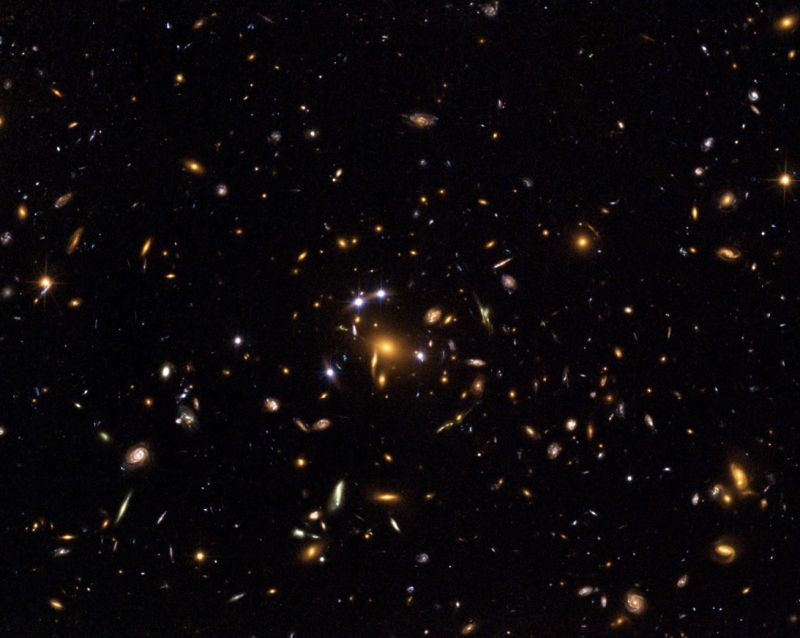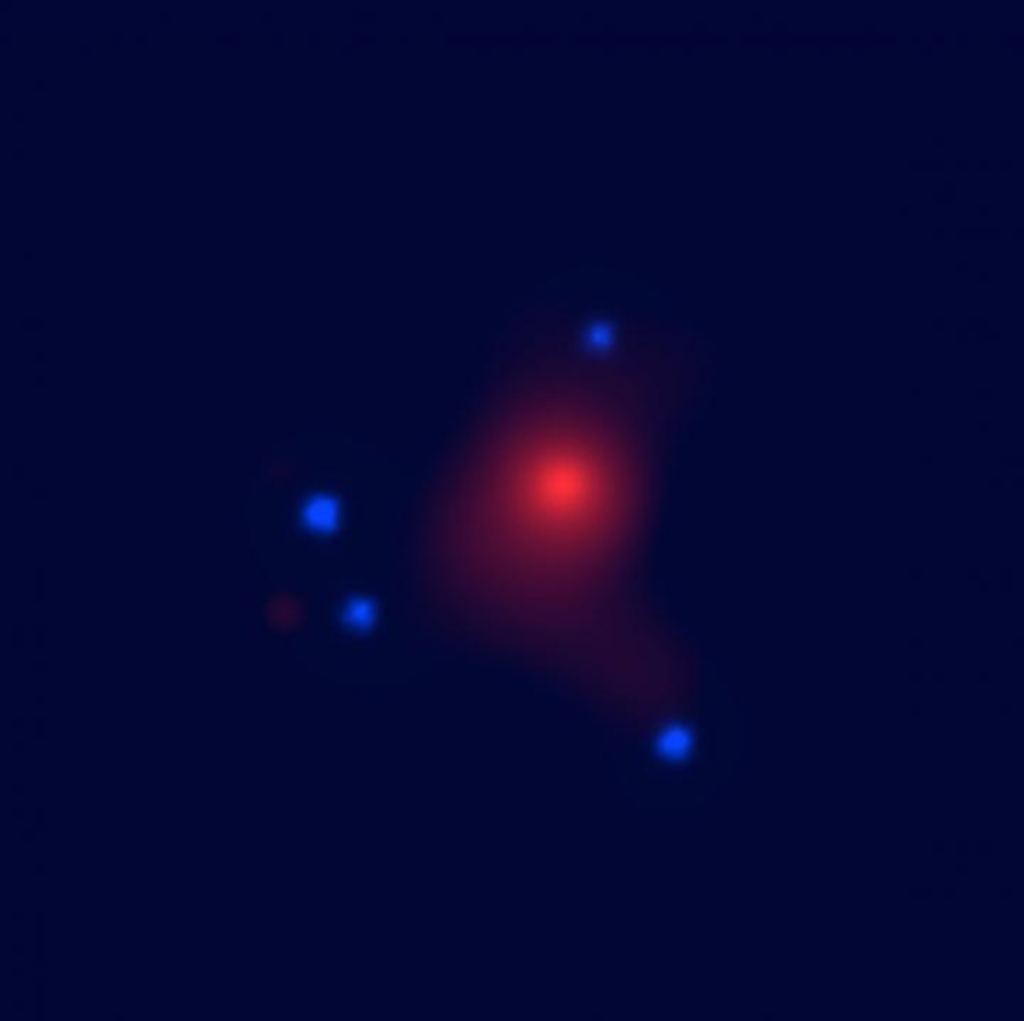A team of researchers at the University of Oklahoma have discovered “planetary mass bodies” outside of the Milky Way. They were discovered in one gravitationally-lensed galaxy, and in one gravitationally-lensed galaxy cluster using a technique called quasar micro-lensing. According to the researchers, the planetary mass objects are either planets or primordial black holes.
These detections are the second and third of this type. The first occurred in 2018 involving some of the same researchers. There is currently no way to directly detect objects like these, and no way to differentiate between planets and small black holes.
“The detection of planet-mass objects, either free-floating planets or primordial black holes, are extremely valuable for modeling of star/planet formation or early universe,” said lead author Dai in a press release. “Even without decomposing the two populations, our limit on the primordial black hole population are already a few orders of magnitude below previous limits in this mass range.”
The new paper outlining these findings is titled “Confirmation of Planet-mass Objects in Extragalactic Systems.” The authors are Saloni Bhatiani, Xinyu Dai, and Eduardo Guerras. The paper is published in The Astrophysical Journal.
We’ve learned a lot about the variety and relative abundance of planets in our own Milky Way galaxy in the last few years. But what about other galaxies? They’re difficult to probe at that level of detail, which means we’ve had very little evidence about extra-galactic planets, only assumptions. But a new technique based on quasar micro-lensing is giving us more evidence.

The technique relies on the light from distant bright Active Galactic Nuclei (AGN) or quasars. Using that light, the researchers were able to study the spectrum in the light signatures of the planetary bodies. This allowed them to “constrain the fraction of these planet-mass objects with respect to the galactic halo.” The objects are about 0.01 % of the total mass of their host galaxies. Their masses range from from Jupiter to Moon mass and provide the most stringent constraints at this mass range.
The two systems are Q J0158-4325 and SDSS J1004+4112.

These objects are gravitationally unbound, and according to the researchers they’re one of two things: rogue free-floating planets that were ejected or scattered during the formation of stars and planets; or primordial black holes. As the researchers say in their paper, “Our analysis suggests that unbound planet-mass objects are universal in galaxies, and we surmise the objects to be either free-floating planets or primordial black holes.”
“We can consistently extract signals from planet mass objects in distant galaxies. This opens a new window in astrophysics.”
Saloni Bhatiani, Co-Researcher and Ph.D. student at OU.
This study shows that planetary-mass objects are likely universal in galaxies. It also provides the first-ever constraints on mass for the intracluster region of a galaxy cluster. For primordial black holes, these limits are several orders of magnitude below previous limits. As they say in their paper, “The planet to stellar scale astronomical dark matter is also known as massive compact halo objects (MACHOs.) It was previously constrained to be less than 10% of the total mass of the Milky Way.” But this work brings that down to about 0.01 % of the total mass of their host galaxies.
“We are very excited about the detections in two new systems,” said Ph.D. student Saloni Bhatiani, who was one of the researchers. “We can consistently extract signals from planet mass objects in distant galaxies. This opens a new window in astrophysics.”
As the paper says, “The number density of FFPs (free-floating planets) not only depends on the detailed ejection processes, but also on the planet formation models. Primordial black holes are thought to be formed during the inflation epoch from quantum fluctuations. Therefore, these planet-mass objects can either serve as a probe of star/planet formation and scattering process, or of fundamental physics in the very early universe in the inflation era.”
So this work is striking because it confirms the existence of planetary-mass objects when the Universe was half the age it is now.

The data that supports this work came from NASA’s Chandra X-ray Observatory. The observational evidence for these planet-mass objects was derived from the microlensing signals that appear as shifts in the X-ray emission line of the quasar. These observational measurements were matched against microlensing simulations that were computed at the OU Supercomputing Center for Education and Research.
Primordial black holes formed in the early universe. They’re largely hypothetical, and if they do exist, they formed in the first second after the Big Bang. At that time, the universe was lumpy rather than homogenous, and astronomers think that some dense, hot regions could’ve collapsed into black holes.
For some time, scientists, including the late Stephen Hawking, thought that dark matter could be primordial black holes. But that theory appears to have been put to bed in a 2019 paper.
More:
- Press Release: OU Research Group Confirm Planet-mass Objects in Extragalactic Systems
- Research Paper: Confirmation of Planet-mass Objects in Extragalactic Systems
- Universe Today: Now We Know That Dark Matter Isn’t Primordial Black Holes


‘A Hubble Space Telescope image of quasar (?) lensed by galaxy cluster SDSS J1004+4112….’
The target object needs to be indicated more clearly !
(Mixed images…?)
Um, did anyone ever have any reason NOT to think that “planetary mass objects” would be in other galaxies? I hope this research is useful.